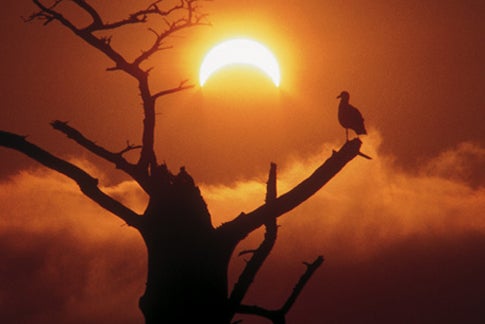Grab your solar-observing gear and get ready for the last solar eclipse of 2007. On September 11, observers in parts of South America, Antarctica, and the South Atlantic will get the opportunity to witness a partial solar eclipse.
An eclipse of the Sun, called a solar eclipse, occurs when the New Moon passes directly between Earth and the Sun. When the Moon’s shadow falls on Earth, people within that shadow see the Moon block a portion of the Sun’s light. The Moon’s shadow has two parts: a penumbra and an umbra. The penumbra is the Moon’s faint outer shadow. Observers within this shadow see a partial solar eclipse, with the Moon covering only part of the Sun’s disk.
The September 11 event begins at 10h25m46s Universal Time (UT), when the Moon’s penumbral shadow makes first contact with Earth. The eclipse ends at 14h36m33s UT as the shadow makes its last contact with Earth. At the point of greatest eclipse, which occurs at 12h31m21s UT, the Moon covers about 75 percent of the Sun’s disk.
How much of the Sun’s disk appears covered by the Moon depends on your observing location. Observers in southern Argentina and Chile will have the best view. In Palmer Station, Antarctica, the Moon will cover up to 70 percent of the Sun’s disk near noon. Most observers in Argentina will see about half of the Sun’s disk covered, while those in Brazil will see about one-fourth of the Sun obscured at greatest eclipse. For those in La Paz, Bolivia, Santiago, Chile, and Lima, Peru, the eclipse will already be in progress at sunrise.
Don’t forget to use proper eye protection when viewing a partial solar eclipse. Use a solar filter with your telescope, wear special solar-eclipse eyeglasses, or construct a pinhole camera and project the Sun’s image onto a piece of paper.










